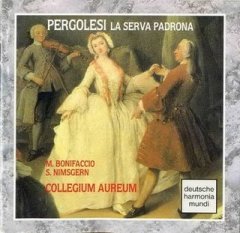Pergolesi – La Serva Padrona (1990)
Pergolesi – La Serva Padrona (1990)

01 - Aspettare, e non venire (Uberto) 02 - Recitativo 03 - Sempre in contrasti (Uberto) 04 - Recitativo 05 - Stizzoso, mio stizzoso (Serpina) 06 - Recitativo 07 - La conosco a quegl' occhietti (Duet) 08 - Recitativo 09 - A Serpina penserete (Serpina) 10 - Recitativo 11 - Son imbrogliato io gia (Uberto) 12 - Recitativo 13 - Per te io ho nel core (Duet) Serpina - Maddalena Bonifacio (soprano) Uberto - Siegmund Nimsgern (bass) Collegium Aureum Franzjosef Maier - Konzertmeister
One of the most successful comic stage works of the entire eighteenth century, Pergolesi's intermezzo La serva padrona was first produced in Naples at the San Bartolomeo theater on September 5, 1733. The function of such works was to serve as an entr'acte piece between the acts of a substantial opera seria -- in this instance Pergolesi's own Il prigioniero superbo, a work subsequently eclipsed by the fame of the intermezzo.
In keeping with the characteristics of the genre, the plot and design of La serva padrona are extremely straightforward; there are only two short acts, and only three characters, one of whom is a mute male servant. The two singing parts are for a middle-aged man, Umberto, and his pert servant Serpina, both drawn from the traditions of commedia dell'arte. The plot concerns Serpina's tricking Umberto into marriage. Pergolesi's music clothes this inconsequential but naturalistic domestic drama in a rich vein of characterization and vitality; the simplicity of means employed would prove enormously influential in the development of comic opera. It is this feature that has led to the mistaken idea that Pergolesi was the founder of opera buffa -- a distinction that more properly belongs to one of his teachers, Leonardo Vinci.
Notwithstanding, the great success achieved by La serva padrona, particularly after its composer's premature death at the age of only 26, unquestionably laid the foundations for the great comic operas of Mozart. In the archetypal characters of the intermezzo we find the progenitors of the more subtly drawn personages of Mozart's Count, and Susanna or Despina. The rapid Europe-wide dissemination of La serva padrona also hastened the reform of the stilted conventions of serious opera, whose stiff formalism lacked the color, verve, and flexibility of the lowbrow newcomer. When it reached Paris in 1752, performances sparked off the famous Querelle des Bouffons, a bitter pamphlet war fought between proponents of Italian opera buffa, and those who supported traditional French classical opera. Few works of such modest pretensions have achieved such great and lasting influence over the course of the development of music. ---Brian Robins, Rovi
download: uploaded yandex 4shared mediafire solidfiles mega filecloudio nornar ziddu
Zmieniony (Wtorek, 11 Marzec 2014 22:23)








